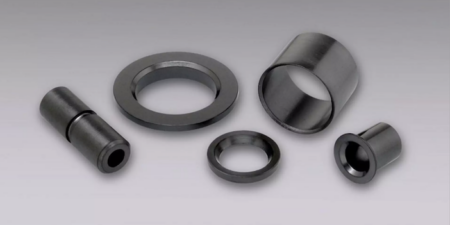14-16 June 2022 saw more than 12,000 professionals from the cabin interiors industry pass through the doors of Hamburg Messe to celebrate the return of Aircraft Interiors Expo (AIX) – the first in-person AIX since the Covid-19 pandemic. The passenger experience community, including representatives from more than 180 airlines, leasing companies and business jet operators, were keen to attend, to reconnect face-to-face with contacts old and new and to try out the latest product launches from over 600 exhibitors.
The event opened with the announcement of many new product launches, showing that exhibitors eager to reveal the innovations and new developments they’ve been working on over the past 36 months. Among the new products, Panasonic Avionics unveiled Astrova, its new in-flight entertainment (IFE) seat-end system. Astrova features cinema-grade 4K OLED screens with High Dynamic Range (HDR), a proprietary Bluetooth technology, as well as 67W of USB-C power to fast-charge smart devices.
Following its launch at a packed stand, the Panasonic team announced that they have worked with fellow AIX exhibitor, Recaro Aircraft Seating, to seamlessly integrate the Astrova seat-end solution into its newly revamped CL3810 economy-class seat.

Indeed AIX 2022 gave the industry their first look at the CL3810 seat, the successor to the German seat manufacturer’s popular CL3710 model. The CL3810 offers weight savings of 1.5kg per seat compared with the CL3710, while still offering ergonomic technology, premium comfort cushions with layered foam, and lightweight smart engineering. The unique shape of the seat is designed to support the passenger’s points of tension, inspired by the design of the Recaro Automotive sport seat. Compared to its predecessor, the CL3810 offers an additional inch of living space, a more advanced articulated seat pan, and a wider backrest to enhance row-to-row privacy.
There were many other seating innovations revealed on the show floor. For example, Aviointeriors was showcasing a range of innovative concepts and configurations, including its Allegra lie-flat business class seat; the Fabry economy class seat, which weighs just 7.5kg; and the flexible ‘Heric’ (Herringbone in Cruise) and ‘DoDo’ (Double Double Bed) family of premium-economy products, which allow seating to be tailored to each airline’s requirements. The Heric and Dodo concepts are designed to be easily converted into lie-flat seating, expanding configuration options for airlines.
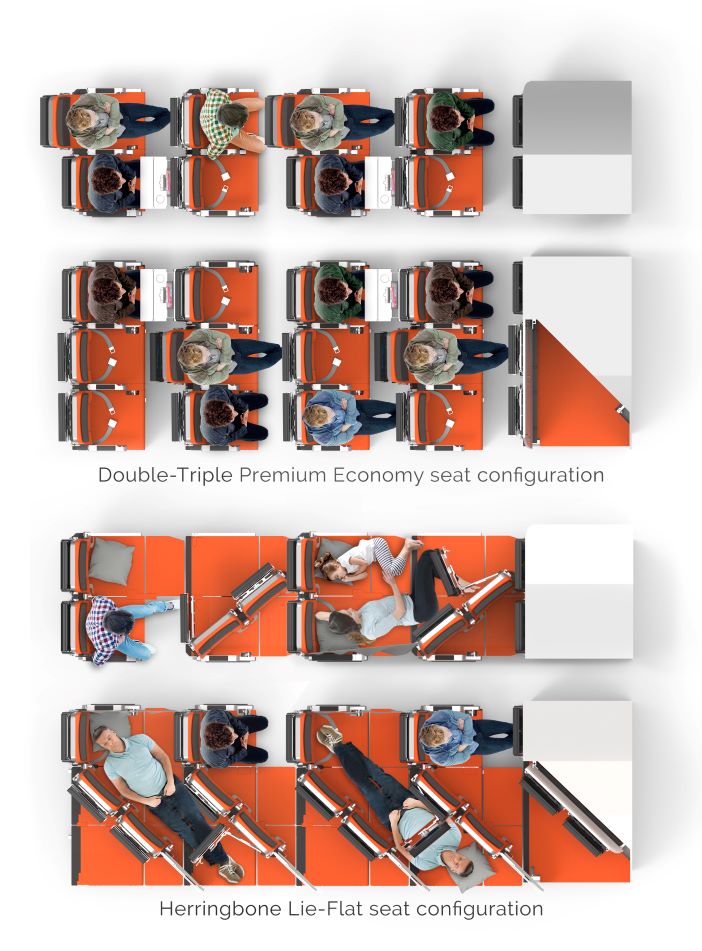
Meanwhile Safran Seats showcased two new business-class products: Vue and Unity. Vue is designed for long-haul flights on narrowbody aircraft, giving the same levels of comfort as a widebody experience. The name, Vue stems from the window-facing view it delivers for every passenger. Meanwhile, Unity is a new generation of high-end, forward-facing business class seats that provide every passenger with direct access to the aisle and multiple storage areas.
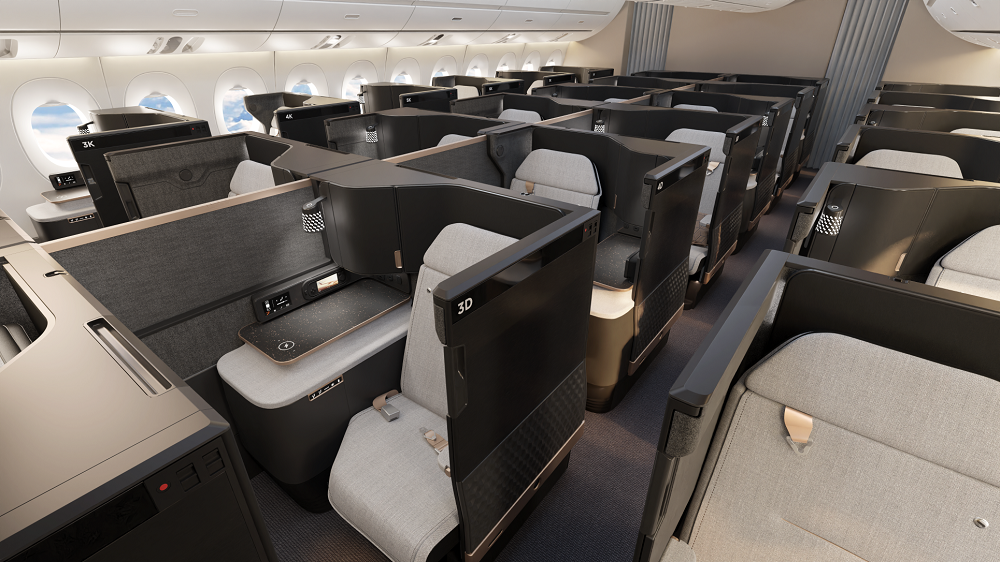
TSI Seats also launched new products: the Milligram economy-class seat, and the Royalux business-class seat. Described as a next-generation lightweight economy class seat, Milligram is optimised for narrowbody A320 and B737 aircraft and is claimed to be one of the lightest seats in the market, weighing less than 7.5kg per passenger (without a dress cover or USB outlet). The low parts count of Milligram – fewer than 70 parts per triple – helps minimise weight, and as those parts are mostly made using ultra-durable, high-performance composites and aluminium, the seat is also durable. Meanwhile the Royalux seat, designed for the A320, A350, B737 and B787, can be used for business class in narrowbody aircraft, or premium economy in widebody aircraft types.
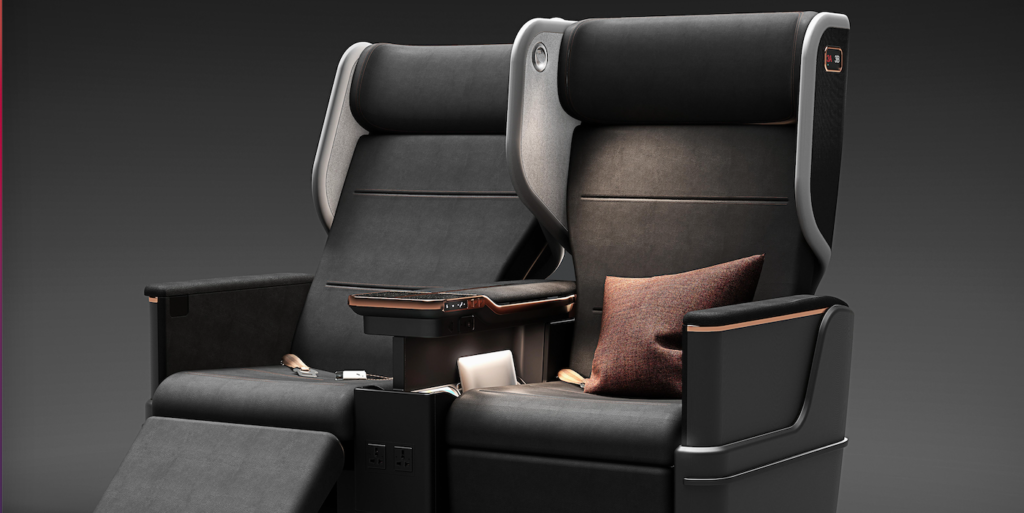
A slightly more fanciful exhibit was the chaise lounge concept on display at Aircraft Interior Refurbishment España’s (AIRE) stand. The design, created by TU Delft student, Alejandro Nunez Vicente, creates a bi-level cabin that has rows of traditional seats on the floor level, and another row above. Nominated for a Crystal Cabin Award in 2021, Alejandro returned to AIX having received funding to work full-time on his prototype.
Ali Aljufairi, Gulf Air’s manager of IFE & connectivity, attended AIX to see and try the latest IFEC and seat innovations. He said of the show, “The return to an in-person event was so important in truly appreciating the different materials being used, the thought put into the design, as well as gaining a more rounded understanding of what the product can offer. This was aided immensely by attending the numerous product launches by seat manufacturers such as Recaro, Stelia and TSI. It is such an educational experience, an institution. If I could describe it in three words, it would be ‘educational’, ‘crucial’ and ‘possibilities’.”
More cabin innovations
Outside of new seating concepts, further product announcements were unveiled across all eight halls of AIX. A highlight was at Airbus’s stand, where the company revealed Airspace Link HBCplus, a flexible high-bandwidth connectivity solution that will be offered as an SFE line-fit catalogue option and also for retrofit on all Airbus programmes. HBCplus initially encompasses Ka-band services, and will enable airlines to connect to a choice of Managed Service Providers (MSPs) via a new certified terminal and radome built as part of the aircraft. In the future, Airbus plans to extend HBCplus to include MSPs that offer Ku-band services.
Airbus also revealed to AIX attendees that it had selected fellow AIX exhibitor and connectivity satcom leader, Inmarsat, as the first MSP, while Safran Passenger Innovations (SPI) will act as terminal provider and hardware integrator of ThinKom’s antenna technology.
Another major attraction was the Collins Aerospace stand, where attendees discovered SpaceChiller, the company’s new modular, thermoelectric cooling system that is scalable to fit a variety of applications throughout an aircraft’s interior. SpaceChiller compartments, whether in a galley or premium seat, quietly and efficiently chill the contents to food-safe temperatures without the use of refrigerants that may impact global warming. The unit is designed to offer airlines flexibility in service, storage and space, without sacrificing room for passengers and flight attendants. Applications range from premium suites and passenger social zones, to single galley inserts and whole cart bays.
SpaceChiller won a 2022 Crystal Cabin Award at an event during AIX week.
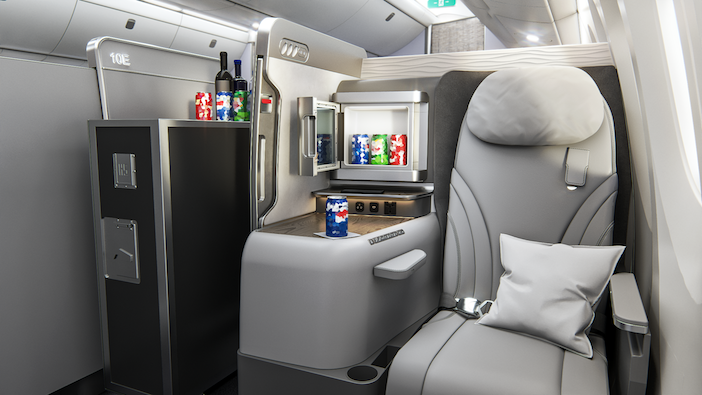
Meanwhile, STG Aerospace declared 2022 a major launch year, with innovations across its core lighting technologies, both photoluminescent and electrical. The company revealed the world’s narrowest and lightest emergency floor path marking – the brand-new saf-Tglo SSUL-X11. This narrow lighting option is designed to enhance cabin aesthetics, blending seamlessly into the cabin design, while maintaining passenger safety requirements. The company also announced its new platform-agnostic Universal Lighting capability and emergency exit system package for business jet and small fixed-wing aircraft (CS23).
Speaking about the return to AIX, Kate Williams, STG Aerospace’s brand marketing manager said, “The show has been really good and really busy. We weren’t sure what to expect after three years, but we’ve been fully booked with meetings and the quality of visitors has been great. We’ve had lots of interest in the new products we’ve launched at the show. The feedback has been really positive and it’s great to know that we’re launching the products our customers want and need.”
A place to learn and discuss future thinking
In addition to the many new product developments showcased on the show floor, AIX also hosted four days of high-level thought leadership as experts from all corners of the industry came together to learn and debate the future of the passenger experience industry. Kick-starting proceedings, the Passenger Experience Conference opened at the newly refurbished Congress Center Hamburg (CCH).
Opening the conference, Paul Wylde, founder, CEO and creative director of Paulwylde delivered an impassioned speech that reflected on the lessons learnt during the pandemic, the changing attitudes of passengers, and the ever-growing importance for brands to watch, observe and understand their audiences. He provided the audience with five key observations, from consumers’ desire to find something meaningful in the brands they choose, to the explosion of the metaverse and the importance of feeling connected. He encouraged brands to foster a culture of creativity, investigation and exploration and to find the will for measured risk-taking.

Following his opening keynote, Wylde was joined by Silvia Mosquera, chief commercial and revenue officer at TAP Air Portugal; Anthony Woodman, vice president for customer journeys & reward at Virgin Atlantic; and moderator Jennifer Newlands, Airbus’s vice president and head of strategy, brand and content, to discuss the critical passenger experience strategies transforming travel and supporting airline renewal.
Meanwhile, two conference streams ran in parallel throughout the afternoon: ‘Rebellious Reconstruction’ and ‘Integrity in Action’, bringing together experts from LIFT Aero Design, Teague, Boeing Commercial Airplanes, Diehl Aviation, Tapis Corporation, Breeze Airways, Cirium, PriestmanGoode, Finnair, Safran Cabin, LSG Group, OneWeb, Viasat, Inmarsat, AERQ, Cathay Pacific and more.
Closing the day, Fabien Pelous, senior vice president of customer experience at Air France, shared candid insights into how the airline is responding to the latest trends and passenger expectations. He explained the role that personalisation is playing and how Air France customers increasingly want more entertainment content and better connectivity. Pelous was joined by Joe Bentley, chief technology officer at Panasonic Avionics, and Jochen Werner, Airbus’s vice president of industrial design, for a final panel discussion, where it was agreed that the way forward required a focus on a sustainable in-flight experience, as well as one that is more connected and personalised for every passenger.
Future cabin trends under the spotlight
Further opportunities to learn and debate future cabin trends were available at CabinSpace LIVE, which returned to the AIX show floor with a programme of sessions offering attendees a chance to reflect on cabin-specific trends and challenges.
A panel of senior industry executives provided attendees with an up-to-date outlook of the commercial aviation and interiors market. In this session, aviation and cabin interiors experts including Andrew Doyle, senior director of market development at Cirium; Gary Weissel, managing officer at Tronos Aviation Consulting; Rob Morris, global head of consultancy at Ascend by Cirium; Elizabeth deYoung, VP of marketing and strategy at Safran Cabin; and Markus Höllerer, head of strategy & products at Recaro Aircraft Seating, all of whom painted an optimistic outlook for the future of their respective industries.
Cirium’s Rob Morris described the industry’s 10-year period of ‘uninterrupted growth’ before the pandemic as ‘driving through thick fog with our foot firmly on the accelerator, only to hit a Covid-shaped brick wall’. However, he was upbeat about the industry’s recovery prospects, demonstrating through modelling calculated by Cirium’s Ascend tool that the future was bright, with one scenario predicting the market could return to pre-pandemic levels by August 2023.
Both Morris and Weissel, however, were keen to stress these were hypothetical outlooks, complicated by many unknowns going forward, particularly the conflict between Russia and Ukraine. Weissel from Tronos predicted that due to said uncertainty, there might be significant changes to the supply chain, such as restructuring processes that could see more production brought in-house – something both DeYoung and Höllerer agreed with. Both too predicted a positive recovery path for the aircraft interiors industry, but the latter acknowledged that the supply chain issue was the primary obstacle before demand and investment could return fully. Other sessions explored how to make sustainable aviation a reality; the how and why of accessible air travel; and the role of women in aviation.
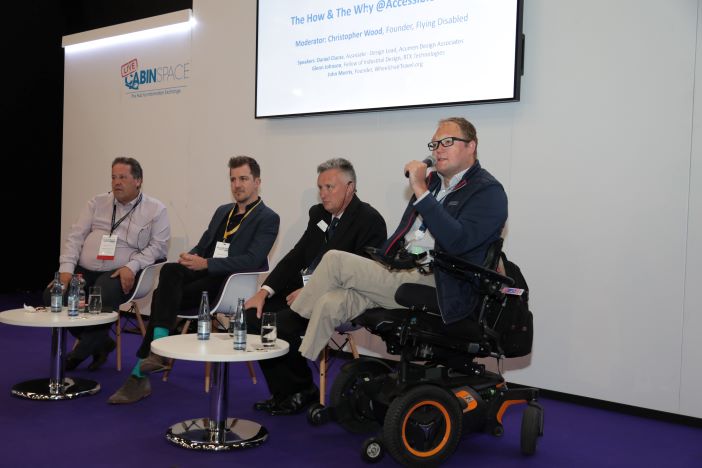
In addition, attendees were treated to an introduction to this year’s Crystal Cabin Award winners. Each company was provided with an opportunity to showcase and introduce their award-winning concepts to the AIX audience, revealing the inspiration behind their innovative designs and their intended applications onboard.
Winners included Safran Cabin’s Fire-Resistant Cargo Container, which took the Health and Safety Award after it convinced the jury with its ability to offer fire containment for Class D fires for up to six hours. The Thales Avionics team also headed to the CabinSpace LIVE stage to introduce the Pulse charging solution for aircraft cabins. Winner of the Materials and Components category, it uses patented power management technology to dynamically allocate power during a flight.
One visitor, Diana Danvova, an IFE engineer at Air Astana, commented on her show experience, stating: “It’s my first time at Aircraft Interiors Expo. I’ve met with so many interesting suppliers who will help me with upcoming projects. As my focus is on IFE, it’s been great to meet with so many relevant companies. There is so much innovation on display, and the chance to meet with my peers has been priceless.”
Getting back to business
With so much innovation and new technology on display, attendees were focused on building existing and new relationships at AIX to discuss future projects, facilitated by the AIX Connect show-planning tool. Designed to help key airline buyers meet exhibitors during the show to build business connections and discuss new projects, the planning tool has never been more relevant as the aircraft interiors industry reconvened for the first time since the global pandemic began. It demonstrated its pivotal role in facilitating the industry’s desire to network, with more than 5,000 confirmed meetings having taken place across the three days of the show.
Commenting on the success of Aircraft Interiors Expo this year, Polly Magraw, event director said, “We have been completely blown away by the response from exhibitors and attendees this year. The atmosphere at this year’s show was extremely positive and demonstrated the appetite among all attendees to reconnect and drive the industry’s recovery. Visitors were able to identify new and exciting products from exhibitors, suppliers had the opportunity to do business with the airline buyers they wanted to meet, and delegates spoke extremely positively about the education opportunities at the conference. I would like to extend my heartfelt thanks to all who joined us over the course of the four days. The breadth of innovation on show was truly remarkable and is a clear demonstration of the resilience and hard work the industry has been firmly focused on during this time.”
Aircraft Interiors Expo (AIX) returns in 2023, from 6-8 June. It will once again be co-located with the World Travel Catering & Onboard Services Expo (WTCE) and Passenger Experience Conference. For more information visit: https://www.aircraftinteriorsexpo.com.



